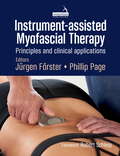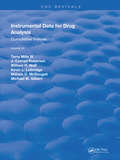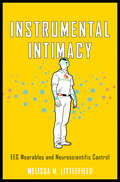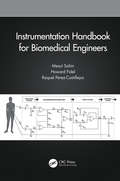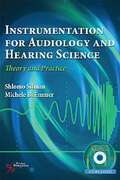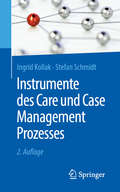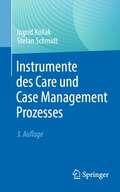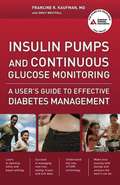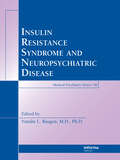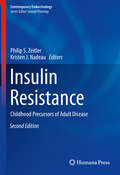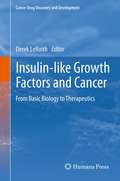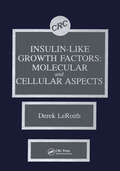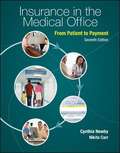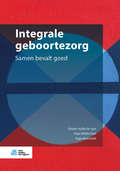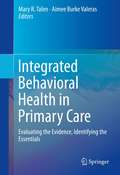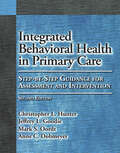- Table View
- List View
Instrument-assisted Myofascial Therapy: Principles and Clinical Applications
by Phil Page Jürgen FörsterInstrument-Assisted Myofascial Therapy: Principles and Clinical Applications provides a complete overview of this effective therapy (IAMT) based on the authors' own clinical experience of using instruments to treat myofascial lesions. The text combines the latest scientific evidence and theory with practical guidelines. The authors describe the use of various IAMT techniques which the reader will be able to easily integrate into daily clinical practice.The text progresses from didactic to practical information of relevance for a variety of clinicians:- Anatomy of the myofascial system and its role in pain/dysfunction and treatments- Science and theory of IAMT including history, types, and research on mechanisms of action and outcomes- Practical application of IAMT Practice: an overview of techniques specific to tissue type (scars, tendons, muscles)- Integration of IATM in clinical practice including clinical decision making (in diagnosis and treatment), indications, contraindications, and adjunct treatmentsThe text is intended to provide a guide for using myofascial instruments in daily practice. The reader will easily learn how to use IATM to enhance patient outcomes and to use it in a fashion which protects their own joints! Procedures are explained and demonstrated using a clear and practical approach. Full-color photographs illustrate the use of the therapy in these commonly-treated areas: Cervical spine and head, Shoulder, Elbow, wrist and hand, Thoracic spine and chest, Lumbar spine and sacroiliac joint, Hip and pelvis, Knee, Ankle and foot.Treatment protocols are provided which can be easily applied by the therapist for use with a variety of diagnoses relating to the same structures by using a standardised and precise approach. A treatment protocol is first presented on a specific structure that is commonly treated. The specific instrument is to be used is described first, then the entire treatment is explained in detail. from the starting position of the therapist and patient. Treatment progressions are then listed, as well as possible treatment options within the Myofascial Connective System (MCS). Beginning with the primarily treated structure, 'myofascial junctions' are discussed; first regionally in a distal and proximal direction, and then within a functional myofascial chain. This unique approach greatly simplifies the various IATM procedures for the reader to easily implement in practice.Readers will learn an integrated approach to IATM in a variety of clinical practice settings. Clinicians seeing post-operative patients will benefit from a chapter dedicated to the treatment of scars. Numerous case studies and the integration of other myofascial techniques (Cupping, Flossing/Mobility Bands, Kinesiology Taping and Fascial Fitness) complete the book.Instrument-Assisted Myofascial Therapy - principles and clinical applications is the result of years of professional practice with IATM while evaluating patient outcomes. The concept is based on scientific evidence and has been developed in close collaboration with leading scientists and practitioners in the field of myofascial therapy. The text provides a pragmatic, evidence-informed approach to IATM practice.
Instrumental Data for Drug Analysis, Second Edition: Volume VII (Forensic And Police Science Ser.)
by Terry MillsVolume 7 of this classic collection presents a comprehensive index to the first six volumes, providing quick and easy access to the data in this exhaustive resource, and completing the set.
Instrumental Intimacy: EEG Wearables and Neuroscientific Control
by Melissa M. LittlefieldA critical examination of the rise of wearable EEG monitors.From Fitbits to GPS trackers, wearables promise to help us understand and improve ourselves in quantified ways. We count our steps, track our location, and even monitor our brain waves as we strive to achieve better fitness, clearer direction, or a more focused mind. But why do we rely on wearables to learn about ourselves? In Instrumental Intimacy, Melissa M. Littlefield questions our desire for mechanistic guidance by examining brain-based EEG wearables that promise to improve sleep, relationships, self-knowledge, and learning. Littlefield focuses specifically on EEGs’ transition out of the laboratory and into the hands of consumers. While other brain-imaging technologies (such as MRI, PET, and MEG) are used only in specialized laboratories, human electroencephalography (a.k.a. EEG) is embedded in portable, user-friendly devices. These direct-to-consumer wearables visualize brain activity as accessible data, and many offer the promise of self-optimization.Littlefield’s illuminating book brings the histories of EEG to bear on the contemporary development of EEG wearables via case studies of EEG-based sleep aids, bio-mapping instruments, fashionable surveillance tools, and athletic training devices. The author argues that, over the past century, applied uses of EEG helped to create new states of mind to be monitored and manipulated, as well as discourses about the existence of brain waves and their viability as a tool for brain optimization. By contextualizing and analyzing EEG wearables, Instrumental Intimacy provides a crucial intervention in an emergent consumer market and in the scholarly fields of STS, critical neuroscience, and the history of technology.
Instrumental Methods in Metal Ion Speciation
by Imran Ali Hassan Y. Aboul-EneinThe knowledge of metal ion speciation is essential for predicting the exact toxicities of metal ion species in the environment. Metal ions can exist in various oxidation states, each of which possesses different physical and chemical properties as well as exhibit varying toxicities. Often, toxicity data is unreliable because it is based on metal io
Instrumentation Handbook for Biomedical Engineers
by Mesut SahinThe book fills a void as a textbook with hands-on laboratory exercises designed for biomedical engineering undergraduates in their senior year or the first year of graduate studies specializing in electrical aspects of bioinstrumentation. Each laboratory exercise concentrates on measuring a biophysical or biomedical entity, such as force, blood pressure, temperature, heart rate, respiratory rate, etc., and guides students though all the way from sensor level to data acquisition and analysis on the computer. The book distinguishes itself from others by providing electrical circuits and other measurement setups that have been tested by the authors while teaching undergraduate classes at their home institute over many years. Key Features:• Hands-on laboratory exercises on measurements of biophysical and biomedical variables• Each laboratory exercise is complete by itself and they can be covered in any sequence desired by the instructor during the semester• Electronic equipment and supplies required are typical for biomedical engineering departments • Data collected by undergraduate students and data analysis results are provided as samples• Additional information and references are included for preparing a report or further reading at the end of each chapter Students using this book are expected to have basic knowledge of electrical circuits and troubleshooting. Practical information on circuit components, basic laboratory equipment, and circuit troubleshooting is also provided in the first chapter of the book.
Instrumentation for Audiology and Hearing Science
by Shlomo Silman Michele B. EmmerUnderstanding the array and complexity of instrumentation available to audiologists and hearing scientists is important to students, beginning clinicians and even seasoned professionals. This book is a comprehensive and accessible look at instrumentation used in these fields. The expert authors introduce the laws of physics as they relate to audiology and hearing science and explain concepts in electronics directly related to instrumentation used in audiology and hearing science (filtering, immittance, digital signal processing including FFT, power reflectance, microphones, receivers, amplifiers, and so forth). They also provide an invaluable introduction to digital technology and further cover details on the calibration of equipment (ANSI standards, audiometer, otoacoustic emissions, and other evoked potentials).
Instrumente des Care und Case Management Prozesses
by Stefan Schmidt Ingrid KollakKomplexe Prozesse professionell überblicken und gekonnt zum Ziel führen!Dieses Buch bietet Fachpersonen aus dem Bereich Pflege und Gesundheitsversorgung einen konzentrierten Einblick über die Instrumente des Care und Case Management Prozesses.Lernen Sie die vielschichtigen Abläufe geschickt zu strukturieren und zielorientiert zu steuern. Mit Hilfe der vorgestellten Instrumente gestalten Sie die einzelnen Prozessphasen positiv und decken konkret die Ressourcen und Bedarfe Ihrer Patienten auf. Sie ermöglichen eine effiziente interdisziplinäre Arbeit und helfen, die vollbrachten Leistungen zu evaluieren.
Instrumente des Care und Case Management Prozesses
by Stefan Schmidt Ingrid KollakKomplexe Prozesse professionell überblicken und gekonnt zum Ziel führen!Dieses Buch bietet Fachpersonen aus dem Bereich Pflege und Gesundheitsversorgung einen konzentrierten Einblick über die Instrumente des Care und Case Management Prozesses. Lernen Sie die vielschichtigen Abläufe geschickt zu strukturieren und zielorientiert zu steuern. Mit Hilfe der vorgestellten Instrumente gestalten Sie die einzelnen Phasen positiv und decken konkret die Ressourcen und Bedarfe Ihrer Patient*innen auf. Sie ermöglichen eine effiziente interdisziplinäre Arbeit und helfen, die vollbrachten Leistungen zu evaluieren.Die 3. Aufl. ist komplett überarbeitet, neu strukturiert und durch neue Instrumente erweitert.
Insulin Pumps and Continuous Glucose Monitoring
by Francine R. KaufmanA diabetes diagnosis no longer means giving up an active life. New technology, such as insulin pumps and continuous glucose monitors, can help people with both type 1 and type 2 diabetes stay active and flexible and maintain healthy attitudes and lifestyles. Insulin Pumps and Continuous Glucose Monitoring explains how this new technology can dramatically improve care, as well as how to prepare for the physical and psychological challenges that come with these new regimens. It provides a comprehensive medical approach to diabetes management and pump therapy with an appreciation for the real-life challenges and frustrations faced every day by people with diabetes. By offering greater flexibility and control, insulin pumps and continuous glucose monitors are revolutionizing glucose management for people on insulin therapy. Dr. Kaufman's book shows how people with diabetes can use this technology to improve not only their diabetes care, but their lives as well.
Insulin Resistance Syndrome and Neuropsychiatric Disease (Medical Psychiatry Series)
by Natalie L. RasgonThis is the first book of its kind to tie the metabolic syndrome with psychiatric disorders and raise the possibility that common antipsychotic treatments may have this type of adverse effect on patients. Presenting a complete overview and the relationship between insulin resistance syndrome and psychiatric and cognitive disorders, the book will be
Insulin Resistance and Cancer: Epidemiology, Cellular and Molecular Mechanisms and Clinical Implications (Energy Balance and Cancer #1)
by I. George FantusThis book reviews the epidemiological associations between insulin resistance and cancer. This is followed by reviews of animal models which support this relationship and provide insight into potential mechanisms. Several chapters then provide detailed examination of the cellular and molecular changes characterizing the insulin resistant state, such as hyperinsulinemia, abnormal metabolism and hormone signaling, and how these interact with various tumor characteristics. For example some tumors present increased quantities of the fetal form of the insulin receptor, unique regulation of oxidative (Krebs' cycle) metabolism (Warburg effect), as well as mutations in various relevant signaling pathways. Finally, the clinical implications of these data are integrated with considerations of insulin "sensitization" and potential metabolic interventions to prevent and treat cancer. It should be noted that while a number of cancers are associated with obesity the authors here have focused primarily on breast cancer as a key and significant model.
Insulin Resistance: Childhood Precursors of Adult Disease (Contemporary Endocrinology)
by Philip S. Zeitler Kristen J. NadeauNow in a revised and expanded second edition, this unique text presents topics related to insulin resistance in youth and its consequences across the lifespan. In the first section of the book examining epidemiology, the contributors review controversies over the definition of insulin resistance in children and what is known about how insulin resistance in youth differs from adults, the measurement of insulin resistance in youth in the research and clinical settings, and current knowledge regarding the epidemiology of insulin resistance in the pediatric population. The second section of the book explores pathophysiology, including current knowledge of the molecular, metabolic, and physiologic mechanisms of insulin resistance, the unique pathophysiology of pregnancy and puberty, the contributions of the prenatal and early childhood environment to the development of insulin resistance, and adipose and biochemical mediators. This section concludes with discussion of the relationship between insulin resistance and cardiovascular disease and liver disorders. A third section, new to this second edition, explores insulin resistance in unique models: intrauterine growth restriction and girls with polycystic ovary syndrome and metabolic syndrome. The final section of the book explores the concepts of treatment through medications directed at insulin sensitivity, as well as exercise, weight loss medications and consequences of bariatric surgery.Insulin Resistance: Childhood Precursors of Adult Disease, Second Edition provides up-to-date reviews of all of these areas, providing the reader with a current perspective on issues in insulin resistance in youth, an emerging risk factor for disease across the lifespan, that will spur continued interest in the topic on the part of clinicians and researchers, perhaps promoting new points of view and creative approaches to this daunting challenge.
Insulin Signaling: From Cultured Cells to Animal Models
by George Grunberger Yehiel ZickWith contributions from the leading researchers in the field, this volume brings together the latest studies on insulin action and signal transduction to provide a state-of-the-art reference for graduate researchers and students in diabetes and endocrinology. Insulin Signaling is a comprehensive study of the regulation of molecular events by insuli
Insulin Therapy
by Mark W. Strachan Brian M. FrierThe aim of this book is to provide clear and concise information about the safe prescribing of insulin both subcutaneously and intravenously. It provides information on the different types of insulin, the delivery devices, side effects of insulin and, most importantly, on rational dose adjustment.
Insulin-like Growth Factors and Cancer
by Derek LeroithThe book will detail the history, successes, and failures of targeted therapies for cancer, with a particular focus on IGF systems and cancer.
Insulin-like Growth Factors: Molecular and Cellular Aspects
by Derek LeRoithDuring the past decade, the continued interest in insulin-related growth factors has been documented by a plethora of research programs and publications focused on these growth factors. Both molecular and cellular biological techniques have improved and enabled investigators to study the properties of the growth factors in depth.This volume covers the molecular (genetic) aspects of the growth factors, their binding proteins and receptors, as well as those factors affecting their gene transcription and translation. In addition, aspects of the cellular action of these growth factors through their receptors and how this impacts normal cellular function are discussed. The book will provide valuable information for researchers in physiology, biology, endocrinology, and metabolism.
Insurance in the Medical Officer: From Patient to Payment
by Cynthia Newby Nikita CarrThis ensures that offices receive maximum, appropriate reimbursement for services provided. Withoutan effective administrative staff, a medical office would have no cash flow! Insurance in the Medical Office is specifically targeted to Medical Assisting students and addresses the role they play in contributing to the financial success of the medical office.
Intangibles: The Unexpected Traits Of High Performing Healthcare Leaders (ACHE Management)
by Amer KaissiWinner of the 2019 ACHE James A. Hamilton Book of the Year Award! As a leader, is it possible to be both successful and humble? Studies show that today’s emerging leaders not only prioritize achievement over humility but also see the two as mutually exclusive. Does this signal an existential crisis for healthcare—an industry that, at its essence, is supposed to embody humility and compassion?Thankfully, no, according to Intangibles: The Unexpected Traits of High-Performing Healthcare Leaders, which demonstrates that you can embrace humility and still be excellent at your job.The author, a healthcare professor, executive coach and consultant, gleans evidence and insights from researchers, executives, philosophers, and thought leaders. Intangibles is neither a self-help book offering prescriptive answers nor a leadership-guru memoir looking back at a lifetime of lessons learned. Rather, it offers an engaging exploration of evidence-based practices from an array of leaders in different settings.The book’s stories, interviews, and research findings will appeal to readers of every stripe and career stage, from undergraduate students in healthcare administration to early careerists and even seasoned CEOs.Part 1 introduces the four intangible leadership traits: humility, compassion, kindness, and generosity. Part 2 explores each trait in detail, and part 3 tackles the traits through the lenses of gender, age, and self-improvement.Along the way, the book explores many intriguing questions: Is humility viewed as weakness? Can leaders balance kindness with a strong personality? How do men and women differ in their perceptions of these traits? Are there generational differences in how leadership is perceived? Can these characteristics be learned?In the end, Intangibles concludes that high-performance in leadership can be achieved when humility is combined with ambition, and compassion with strength.
Integer Linear Programming in Computational and Systems Biology: An Entry-Level Text and Course
by Dan GusfieldInteger linear programming (ILP) is a versatile modeling and optimization technique that is increasingly used in non-traditional ways in biology, with the potential to transform biological computation. However, few biologists know about it. This how-to and why-do text introduces ILP through the lens of computational and systems biology. It uses in-depth examples from genomics, phylogenetics, RNA, protein folding, network analysis, cancer, ecology, co-evolution, DNA sequencing, sequence analysis, pedigree and sibling inference, haplotyping, and more, to establish the power of ILP. This book aims to teach the logic of modeling and solving problems with ILP, and to teach the practical 'work flow' involved in using ILP in biology. Written for a wide audience, with no biological or computational prerequisites, this book is appropriate for entry-level and advanced courses aimed at biological and computational students, and as a source for specialists. Numerous exercises and accompanying software (in Python and Perl) demonstrate the concepts.
Integrale geboortezorg: Samen bevalt goed
by Hajo Wildschut Inge BoesveldDit boek behandelt de vele aspecten van wetenschappelijk verantwoorde integrale geboortezorg. En laat zien welke eisen eraan gesteld worden. Hierbij is het van belang dat zorgprofessionals over de grenzen van hun eigen discipline heen kijken en samenwerken met collega’s uit andere disciplines.Integrale geboortezorg betekent dat de (aanstaande) ouders en het kind de spil zijn waar de zorg om draait. Integrale geboortezorg betekent ook dat zorgprofessionals over de grenzen van de eigen discipline heen kijken, met het accent op samenwerking. Samenwerking tussen verschillende disciplines die bij het zorgtraject zijn betrokken. Dat traject begint al vóór de bevruchting en loopt door tot het kind twee is.Aan bod komen onder andere positie van de (aanstaande) ouder(s) en het kind, kwaliteit van zorg, risicomanagement, taken en verantwoordelijkheden, omgang met klachten, incidenten, complicaties en calamiteiten, integraal zorgdossier en e-health, financiële aspecten, deskundigheidsbevordering en het belang van interprofessionele samenwerking.Dit boek is bedoeld als een handreiking voor alle zorgprofessionals werkzaam in de geboortezorg. Het maakt nieuwsgierig; het zegt niet hoe het moet, wel hoe het kan.
Integrale zorg voor mensen met een chronische ziekte: Vanuit patiëntverhalen naar een nieuw perspectief op de zorg
by Henk Rosendal Lausanne MiesIk heb moeten leren dat ik als patiënt zeggenschap heb over de manier waarop ik behandeld word. Dat het goed is zelf na te denken over mijn wensen en dat ik aangeef hoe ik wil dat zorgverleners met mij omgaan.' Anke de Jong-Koelé Verhalen van mensen met een chronische ziekte staan centraal, zowel in het leer-werkboek als op de bijbehorende dvd. Uit deze verhalen blijkt dat patiënten geen onderscheid maken tussen zorg en welzijn, en ook niet redeneren vanuit een bestaand (zorg)aanbod. Zij willen vooral leren omgaan met de beperkingen die ze ondervinden in hun dagelijks leven. Zorgprofessionals uit de praktijk hebben in focusgroepen op deze verhalen gereflecteerd om de werkelijke problemen en uitdagingen voor eerstelijnszorg boven tafel te krijgen. Vooral de kwaliteit van leven is belangrijk. Iemands medische situatie is daar slechts een onderdeel van. Hoe kan de zorg zich meer richten op de mens en zijn functioneren, en minder op de aandoeningen? Daarvoor moeten professionals een nieuwe werkwijze aanleren: integraal, kritisch en creatief. Dit leer-werkboek bevat veel materiaal om hiermee te oefenen. 'Standaardoplossingen voor mensen met een chronische ziekte werken niet. Dat laat dit boek helder zien. Voor een goede hulpverlening is een open, kritische blik nodig op het leven van iedere patiënt. En vervolgens creativiteit en samenwerking. Een onmisbaar boek in elke opleiding voor zorg en welzijn.' Prof.dr. A.J.P. Schrijvers, hoogleraar Public Health, UMC Utrecht
Integrated Approaches to Infertility, IVF and Recurrent Miscarriage: A Handbook
by Justine Bold Dian Shepperson Mills Kamran Rostami Deborah Cook Irina Szmelskyj Lisa Attfield Natasha Claire Dunn Professor Gab Kovacs Karen Macgillivray-Fallis Karen Veness Clare Casson Susan Bedford Dr Mohammed Rostami-Nejad Louise CarderA comprehensive integrative handbook on fertility treatment, and Assisted Reproduction Techniques (ART), the book is written by specialist contributors for health professionals and Complementary and Alternative Medicine (CAM) practitioners, and for those seriously considering ART themselves. Integrated approaches to infertility offer both a greater awareness and understanding of the combination of factors that can influence the chances of success when undergoing different types of ART. Leading experts review the evidence and discuss the benefits of different approaches to support the physiological and emotional aspects of fertility and fertility treatment. The book covers everything from identifying and treating conditions that may reduce fertility, including immunological abnormalities and specific male and female factors, to how nutrition, acupuncture, reflexology and yoga can support couples going through assisted reproduction, including helping to improve some immunological aspects. There is also a chapter that looks specifically at support for the over 40's.
Integrated Behavioral Health Practice
by Michael A. ManciniThis valuable resource prepares graduate-level students in social work and other helping professions to provide integrated behavioral health services in community-based health and mental healthcare settings. Responding to the increasing prevalence of behavioral health issues in the general U.S. population and the resulting additional responsibilities for social workers and health professionals, this textbook describes the latest evidence-based practices and interventions for common behavioral health disorders as well as issues related to suicide, violence, substance use, and trauma. Detailed case studies help illustrate the effects of a range of interventions, inviting readers to consider how best to implement behavioral health assessment and treatment practices that are evidence-based, trauma-informed, and recovery-oriented. In addition to outlining integrated behavioral health service models and assessment tools, chapters address specific topics such as: Public health approaches to addressing interpersonal violenceIntersections of social, behavioral, and physical healthAchieving recovery and well-being from behavioral health disordersMotivating clients to achieve and maintain recovery from addictionStage-based treatments for substance use disordersCognitive behavioral approaches to treating anxiety and depressive disordersEvidence-based approaches to treating the effects of trauma and PTSD Integrated Behavioral Health Practice equips graduate students and health professionals alike to provide sensitive and informed interprofessional care for patients and families while consistently engaging in practices that emphasize recovery and well-being.
Integrated Behavioral Health in Primary Care
by Aimee Burke Valeras Mary R. TalenContributed by experts who've developed integrative healthcare initiatives with strengths in the areas of policy and principles, organizational systems, or clinical practice. These contributors will illustrate the concepts and describe the nuts and bolts of their integration initiatives. In the conclusion of each section, the editors will construct a template to systematically evaluate these essential elements. This template will organize the information to help stakeholders compare and contrast the strengths, resources, limitations, and challenges of how each model meets the vision of integrative healthcare. In the concluding section the information in the preceding sections connects to provide a coherent synopsis of the common themes and practices, from the macro to micro levels of care, which foster successful integration of the medical and psychosocial systems.
Integrated Behavioral Health in Primary Care: Step-By-Step Guidance for Assessment and Intervention
by Christopher L. Hunter Dr. Jeffrey L. Goodie Mark S. Oordt Anne C. DobmeyerThis timely new edition of Integrated Behavioral Health in Primary Care brings the reader up to speed with the changing aspects of primary care service delivery in response to the Patient-Centered Medical Home (PCMH), the Triple-Aim health approach, and the Patient Protection and Affordable Care Act. Drawing on research evidence and years of experience, the authors provide practical information and guidance for behavioral health care practitioners who wish to work more effectively in the fast-paced setting of primary care, and provide detailed advice for addressing common health problems such as generalized anxiety disorder, depression, weight issues, sleep problems, cardiovascular disorders, pain disorders, sexual problems, and more. New to this edition are chapters on population health and the PCMH; children, adolescents, and parenting; couples; managing suicide risk; and shared medical appointments.
